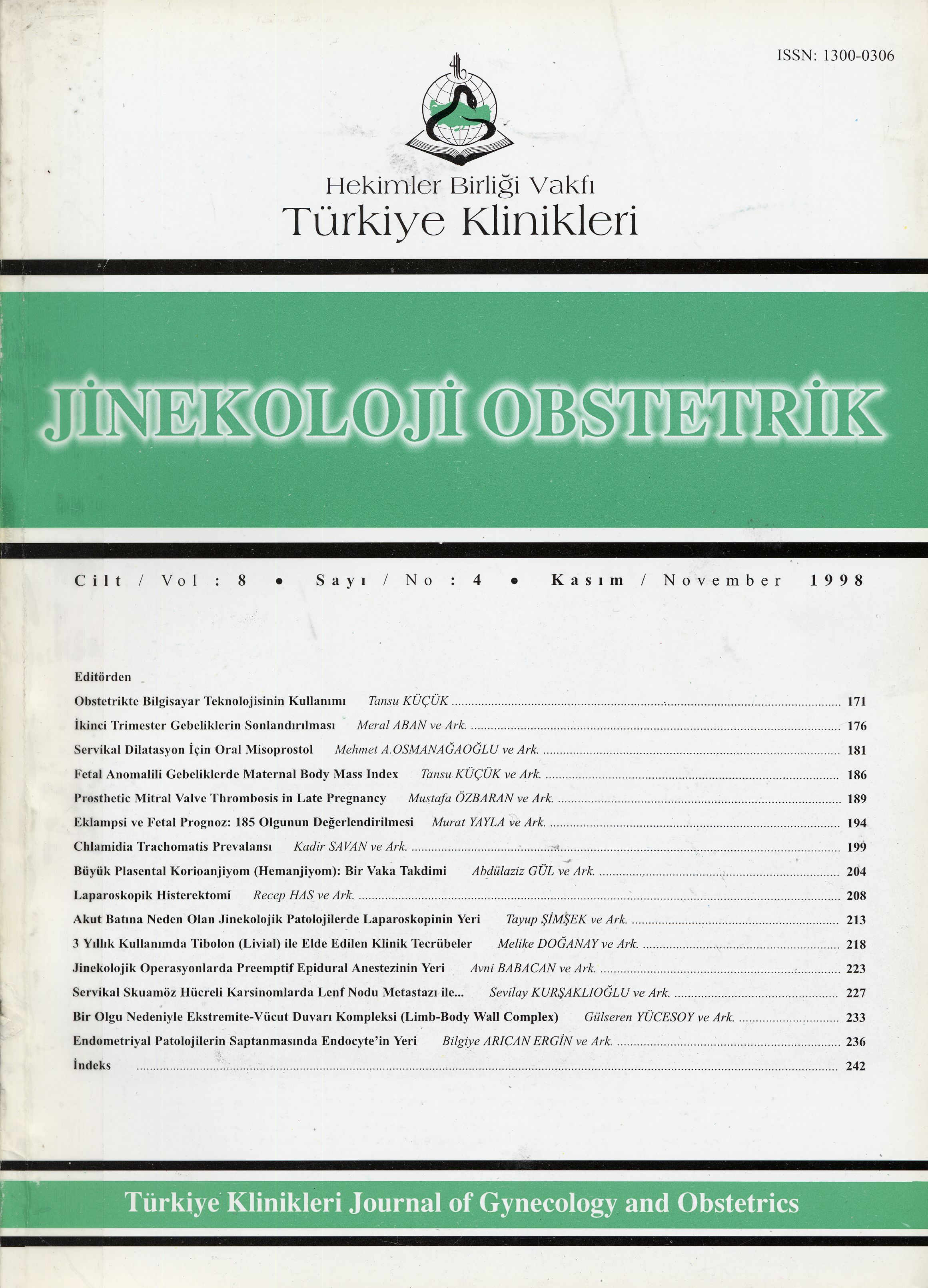Open Access
Peer Reviewed
ARTICLES
3149 Viewed1039 Downloaded
Premptive Epidural Analgesia In Gynecologic Operations
Jinekolojik Operasyonlarda Preemptif Epidural Anestezinin Yeri
Turkiye Klinikleri J Gynecol Obst. 1998;8(4):223-6
Article Language: TR
Copyright Ⓒ 2025 by Türkiye Klinikleri. This is an open access article under the CC BY-NC-ND license (http://creativecommons.org/licenses/by-nc-nd/4.0/)
ÖZET
Amaç: Bu çalışmanın amacı operasyondan önce preemptif analjezi tekniğine göre epidural kateterden lokal anestezik uygulanan grubun postoperatif analjezi düzeyini ve analjezik gereksinimini gözlenen olgu sayısını kontrol grubuyla kıyaslamaktadır. Yapıldığı yer, Materyal ve Metod: Gazi Üniversitesi Tıp Fakültesinde myomektomi ve histerektomi geçirecek 24 olgu randomize olarak iki gruba ayrıldı. Premedikasyonu takiben her iki gruba operasyondan önce epidural kateter yerleştirildi. Kontrol grubuna (Grup 1) operasyondan önce epidural kateter aracılığıyla serum fizyolojik uygulanırken, ikinci gruba (Grup 2) lokal anestezik uygulandı. Postoperatif 1., 4., 8., 12., 16., 20. ve 24. saatlerdeki vizüel analog skala (VAS) değerleri ve buna göre her iki grupta analjezik gereksinimi olan olgu sayısı kaydedildi ve insidansı tespit edildi. Bulgular: Her iki grubun postoperatif VAS değerleri birbirinden farksız olmasına rağmen, grup içinde istatistiksel olarak anlamlı fark gözlendi. Kontrol grubunda postoperatif analjezik gereksinimi gözlenen olgu sayısı ve insidansı, istatistiksel olarak anlamlı olmasa da diğer gruptakinden daha yüksek bulundu. Sonuç: Bu çalışmada gruplar arasında analjezi düzeyinde ve postoperatif analjezik gereksinimi gösteren olgu sayısında istatistiksel olarak amlamlı bir farklılık bulunmadı. Bu nedenle preemptif analjezi yardımıyla santral sinir sistemindeki fonksiyonel değişikliklerden kaçınmak için daha fazla çalışma yapılması gerektiğine inanıyoruz.
Amaç: Bu çalışmanın amacı operasyondan önce preemptif analjezi tekniğine göre epidural kateterden lokal anestezik uygulanan grubun postoperatif analjezi düzeyini ve analjezik gereksinimini gözlenen olgu sayısını kontrol grubuyla kıyaslamaktadır. Yapıldığı yer, Materyal ve Metod: Gazi Üniversitesi Tıp Fakültesinde myomektomi ve histerektomi geçirecek 24 olgu randomize olarak iki gruba ayrıldı. Premedikasyonu takiben her iki gruba operasyondan önce epidural kateter yerleştirildi. Kontrol grubuna (Grup 1) operasyondan önce epidural kateter aracılığıyla serum fizyolojik uygulanırken, ikinci gruba (Grup 2) lokal anestezik uygulandı. Postoperatif 1., 4., 8., 12., 16., 20. ve 24. saatlerdeki vizüel analog skala (VAS) değerleri ve buna göre her iki grupta analjezik gereksinimi olan olgu sayısı kaydedildi ve insidansı tespit edildi. Bulgular: Her iki grubun postoperatif VAS değerleri birbirinden farksız olmasına rağmen, grup içinde istatistiksel olarak anlamlı fark gözlendi. Kontrol grubunda postoperatif analjezik gereksinimi gözlenen olgu sayısı ve insidansı, istatistiksel olarak anlamlı olmasa da diğer gruptakinden daha yüksek bulundu. Sonuç: Bu çalışmada gruplar arasında analjezi düzeyinde ve postoperatif analjezik gereksinimi gösteren olgu sayısında istatistiksel olarak amlamlı bir farklılık bulunmadı. Bu nedenle preemptif analjezi yardımıyla santral sinir sistemindeki fonksiyonel değişikliklerden kaçınmak için daha fazla çalışma yapılması gerektiğine inanıyoruz.
ANAHTAR KELİMELER: Analjezi, Preemptif anestezi tekniği, Epidural lokal anestezik, Lidokain ve bupivakain
ABSTRACT
Objective: The aim of this study is to compare the level of postoperative analgesia and the frequency of analgesic requirement of the group administered local anaesthetic via epidural catheter before the operation according to the preemptive analgesia technique with respect to the control group. Institution, Materials and Methods: Twenty-four patients undergoing myomectomy and hysterectomy at Gazi University Faculty of Medicine were randomly allocated into two groups. Following premedication, epidural catheters were inserted to both of the groups before the operation. While saline was administered to the control group (Group 1) via epidural catheter before the operation, local anaesthetic was administered to the second group (Group 2). Visual analog scala (VAS) values at postoperative 1., 4., 8., 12., 16., 20. and 24., hours were recorded and the frequency of analgesic requirements of the groups were determined according to it. Results: Although postoperative VAS values were not significantly different between the groups, they were significantly different within the group (p<0.01 and p<0.001). The frequency of postoperative analgesic requirement of the control group was higher than the other group, which was statistically insignificant. Conclusion: In the present study we did not observe any statistically significant difference at the analgesia level and the frequency of analgesic requirements between the groups. Therefore, we believe that further studies have to be performed to avoid functional changes of the central nervous system by the aid of preemptive analgesia.
Objective: The aim of this study is to compare the level of postoperative analgesia and the frequency of analgesic requirement of the group administered local anaesthetic via epidural catheter before the operation according to the preemptive analgesia technique with respect to the control group. Institution, Materials and Methods: Twenty-four patients undergoing myomectomy and hysterectomy at Gazi University Faculty of Medicine were randomly allocated into two groups. Following premedication, epidural catheters were inserted to both of the groups before the operation. While saline was administered to the control group (Group 1) via epidural catheter before the operation, local anaesthetic was administered to the second group (Group 2). Visual analog scala (VAS) values at postoperative 1., 4., 8., 12., 16., 20. and 24., hours were recorded and the frequency of analgesic requirements of the groups were determined according to it. Results: Although postoperative VAS values were not significantly different between the groups, they were significantly different within the group (p<0.01 and p<0.001). The frequency of postoperative analgesic requirement of the control group was higher than the other group, which was statistically insignificant. Conclusion: In the present study we did not observe any statistically significant difference at the analgesia level and the frequency of analgesic requirements between the groups. Therefore, we believe that further studies have to be performed to avoid functional changes of the central nervous system by the aid of preemptive analgesia.
MENU
POPULAR ARTICLES
MOST DOWNLOADED ARTICLES





This journal is licensed under a Creative Commons Attribution-NonCommercial-NoDerivatives 4.0 International License.










